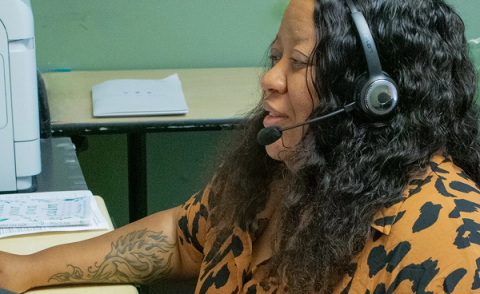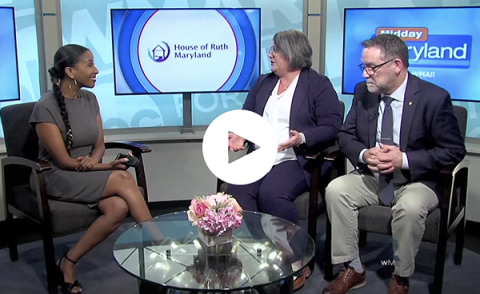Let’s Talk Change:
Breaking the Cycle of Abuse, One Call at a Time
The Gateway 2 Change hotline offers a new model to prevent intimate partner violence.
Why This
Matters
Intimate partner violence (IPV) affects millions of people in the United States each year. For survivors, individuals who use violence, and their loved ones, the cycle of abuse can feel impossible to break. Harm-reduction resources for survivors have expanded, but individuals at risk of using violence lack access to early intervention or crisis response, leaving families with few places to turn for support.
The Facts:
A New Solution for
Breaking the Cycle of Violence
To prevent the devastating consequences of intimate partner violence, House of Ruth Maryland — working with the Johns Hopkins Bloomberg School of Public Health, and the Bloomberg American Health Initiative — created Gateway 2 Change, the first 24/7 hotline in the United States for people at risk of harming an intimate partner. This new resource offers people in Maryland — or in other communities who adopt the model — the support they need to break the cycle of violence and choose a better path.
The Gateway 2 Change Hotline
Expanding the Reach of Public Health Prevention
Gateway 2 Change is a 24/7 anonymous and confidential hotline for people at risk of harming an intimate partner. Learn more about this community resource for helping to reduce intimate partner violence in your community.
Who is it for?
The Gateway 2 Change hotline is dedicated to those at risk of causing harm to an intimate partner. Survivors, friends, family, and community members can also call for guidance on supporting someone who has been abusive toward an intimate partner.
How does it work?
A live person answers 24/7 to listen, not judge. Callers decide what to share and can expect a calm, private conversation where they’re truly heard. Hotline advocates listen to understand caller needs and meet them where they are — whether uncertain about next steps or ready for support in refraining from violence. Before the call ends, the hotline advocate works with the caller to identify what's needed to help ensure safety for them and their loved ones.
What makes it unique?
The Gateway 2 Change hotline fills a critical gap in violence prevention: no other 24/7 hotline exists specifically for people at risk of causing harm to an intimate partner. People at risk of causing harm to an intimate partner are provided trauma-informed, accountability-centered assistance from experts in abuse intervention. By supporting potential perpetrators of intimate partner violence, this hotline is also protecting the lives of their potential victims.
Why focus on those at risk of causing harm to an intimate partner rather than the victim?
Historically, most interventions aiming to reduce rates of intimate partner violence support victims, not those at risk of using violence. The Gateway 2 Change hotline addresses violence at its source by providing a safe, confidential space to reflect, acknowledge harm, and take steps toward nonviolence. Our trauma-informed approach works to end patterns of abuse.
- Citation: (Ogbe, E., Harmon, S., Van den Bergh, R., & Degomme, O. (2020)
What research is it built on?
Gateway 2 Change builds on House of Ruth’s Gateway Project—an evidence-based abuse-intervention program established in the 1970s—and on sustained academic–practice partnerships that have refined HRM’s approach over time. Developed within a public-health framework, the hotline integrates accountability-focused, stage-based harm reduction with motivational interviewing and a social-marketing pilot. The model is grounded in formative research with people who have used intimate partner violence and other key stakeholders, shaped by violence-prevention and crisis-intervention experts, and refined through an ongoing process evaluation.
- Citation: Murphy, C. M., Richards, T. N., Nitsch, L. J., Green-Manning, A., Brokmeier, A. M., LaMotte, A. D., & Holliday, C. N. (2021). Community-informed relationship violence intervention in a high-stress, low-income urban context. Psychology of Violence, 11(6), 509-518. https://doi.org/10.1037/vio0000387
How does a community member get help for a loved one now?
Call 667-240-8977 if you’re in Maryland to talk through your concerns and explore safe, constructive ways to support change and remain safe. Outside of Maryland, please contact 800-799-7233.
Seven Lessons Learned
Ready to bring Gateway 2 Change to your community?
These seven practice-tested moves to drive change are supported by early findings.
1. Confidentiality builds trust and safety
An anonymous and confidential entry point reduces stigma and opens the door to change.
- Practice: 24/7 live answer, clear confidentiality script, and no automatic police involvement, so families have a non-legal option to address abusive behavior.
- Key Findings: People at risk of being violent to an intimate partner called the hotline, disclosed their abuse to an advocate, and sought services related to their needs.
2. Make it about prevention, not just crisis
Stage-based conversations guided by Motivational Interviewing build readiness and accountability.
- Practice: Use accountability-focused, stage-based harm reduction with motivational interviewing to meet callers where they are and support change.
- Key Findings: Callers articulated change goals, participated in voluntary drop-in abuse intervention, and accepted referrals.
3. Address the root causes of violence perpetration
Referrals to community-based services address drivers of harm.
- Practice: Real-time connections to abuse-intervention, mental health, legal support, and other relevant services.
- Key Findings: Referrals were offered and accepted, including participation in a drop-in abuse intervention group.
4. Invest in training skilled and supportive advocates
Hotline advocates sustain safety and build trust.
- Practice: Standard protocols, supervision/debriefs, and supports for secondary traumatic stress.
- Key Findings: Consistent protocol use and safe call handling of complex calls without service disruption or adverse survivor impact.
5. Engage the broader community
Activating survivors and community partners normalizes help-seeking for abusive behavior.
- Practice: Toolkits, scripts, and cross-training for friends, family, and providers to support someone using abusive behaviors.
- Key Findings: Survivors and partners viewed the hotline as credible; attitudes shifted toward intervention and accountability.
6. Build on what works
Building on experience refines protocols and improves safety.
- Practice: Apply lessons from direct work with people using abusive behaviors to sharpen an accountability-focused, stage-based harm-reduction approach with motivational interviewing; update safety checks, de-escalation steps, and referral scripts through ongoing call reviews.
- Key Findings: More consistent protocol use, clearer referral recommendations, increased advocate confidence, and safe handling of complex calls without service disruption.
7. Design–test–adapt
Build a learning loop using a public health approach.
- Practice: Map a clear theory of change; use rapid formative testing to tune scripts, safety checks, and referrals; monitor fidelity/referrals/adverse events; huddle regularly to adjust.
- Key Findings: Faster, safer iterations; tighter protocol fidelity; better MI–stage fit; clearer referrals; no adverse survivor impact.
It's a really important shift when we’re speaking to those who may cause harm to an intimate partner, to hold empathy for them and compassion, of course, and also help them remove the shame while holding accountability.
We know that the criminal legal system is not a safe resource for all families, and so it's important that people be able to engage with our services without needing a court order... What we've really been focused on is reducing those barriers to engagement...And it starts with this hotline.
Resources
Downloads
This guide includes hotline best practices, a readiness assessment, and evaluation metrics. It also offers practical guidance for protocol development, staffing, training, and outreach.
Once the hotline is established, this guide can help staff effectively navigate calls while ensuring the caller feels heard and safe.
Media
The House of Ruth Maryland has supported survivors of violence by intimate partners for decades. It's learned that to end that violence, not just cope with it, abusers need access to help, too.
House of Ruth Maryland leads the fight to end intimate partner violence against women, men, and their children by confronting the attitudes, behaviors and systems that perpetuate it, and by providing victims with the services necessary to rebuild their lives safely and free of fear.
Request
Information & Technical Assistance
If you are interested in learning more about Gateway 2 Change, implementing a similar model, or exploring research and evaluation opportunities, our team is here to help. Please complete the form or email info [at] hruthmd.org or Charvonne [at] rootedhealthstrategies.com.


